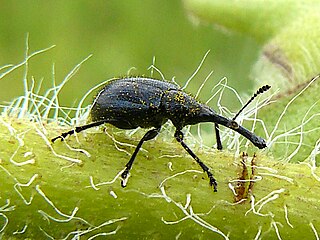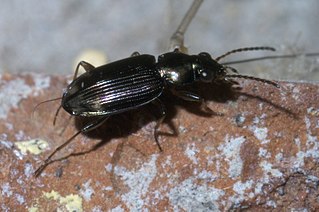Macrodactylus angustatus is a species of scarab beetle in the family Scarabaeidae. It is found in North America. A yellow beetle with an elongate shape and long legs, it is 7-10mm long, and may be found on shrubs. Its range is Massachusetts to Indiana in the north, and south to Florida and Texas.

Scarites subterraneus, known generally as the big-headed ground beetle or (tunneling large)pedunculate ground beetle, is a species of ground beetle in the family Carabidae. It is found throughout the Caribbean, Central America, and North America.

Haplorhynchites aeneus, known generally as the head-clipping weevil or sunflower headclipping weevil, is a species of leaf rolling weevil in the beetle family Attelabidae. It is found in North America.
Notiophilus novemstriatus is a species of ground beetle in the family Carabidae. It is found in North America, occurring throughout the eastern U.S. states and as far west as Arizona. Approximately 4.5mm long, it is a brassy black color, with a wide head and large eyes.
Microweisea misella is a species of lady beetle in the family Coccinellidae. It is found in North America. Darkly colored and very small at about 1 to 1.5mm in length, it occurs throughout southern Canada and much of the United States. It preys on Diaspididae scale insects on blueberry and other shrubs and trees.
Notiophilus aeneus, also known as the brassy big-eyed beetle, is a species of ground beetle in the family Carabidae. It is found in North America. Approximately 5–6 mm long, it is dark colored with a brassy tinge and large eyes. Adults are diurnally active in spring and summer.

Penthe obliquata, also known as the oblique polypore fungus beetle is a species of polypore fungus beetle in the family Tetratomidae. It is found in North America.

Polyphylla variolosa, the variegated June beetle, is a species of scarab beetle in the family Scarabaeidae. It is found in North America. It is reddish-brown and a little over two centimeters long. The club ends of the antennae are longer in the males than the females, and have seven antennomeres. Its habitat is sandy soils primarily near the Great Lakes and coastal regions from Quebec south to Virginia.
Rhizophagus dimidiatus is a species of root-eating beetle in the family Monotomidae. It is found in North America.

Bembidion rapidum is a species of ground beetle in the subfamily Trechinae. It is found in Canada and the United States. It is 3.8–4.4 mm (0.15–0.17 in) long and black with brassy reflections.
Rhizophagus grouvellei is a species of root-eating beetle in the family Monotomidae. It is found in North America.
Languria taedata is a species of lizard beetle in the family Erotylidae. Dark and elongate, it is 9mm to 11mm long. Its larvae grow inside the stems of cordgrass. It is found in North America, especially along the eastern coastal states.
Rhizophagus brunneus is a species of root-eating beetle in the family Monotomidae. It is found in Central America and North America.

Hyperaspis octavia is a species of lady beetle in the family Coccinellidae. It is found in North America. It is about 2.5mm long, oval-shaped, and shiny black with pale red-brown spots. The legs are also a paler brown.
Rhizophagus sculpturatus is a species of root-eating beetle in the family Monotomidae. It is found in North America.

Diomus terminatus is a species of lady beetle in the family Coccinellidae. It is found in throughout eastern North America. It is brown and oval-shaped, with a reddish tinge at the back portion of its elytra, and about 1.5 to 2 mm. It is covered in gold-colored setae, giving it a slightly hairy appearance. Its prey likely includes aphids, scale, and mealybugs.
Rhizophagus minutus is a species of root-eating beetle in the family Monotomidae. It is found in North America.
Rhizophagus remotus is a species of root-eating beetle in the family Monotomidae. It is found in North America.
Rhizophagus sayi is a species of root-eating beetle in the family Monotomidae. It is found in North America.

Rhizophagus parallelocollis, the graveyard beetle, is a species of root-eating beetle in the family Monotomidae. It is found in North America and Europe.







